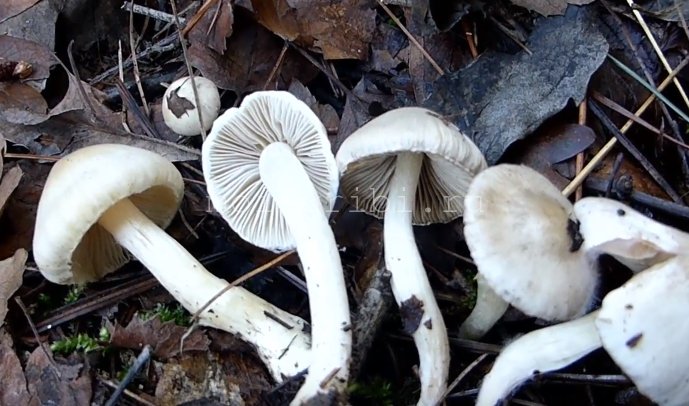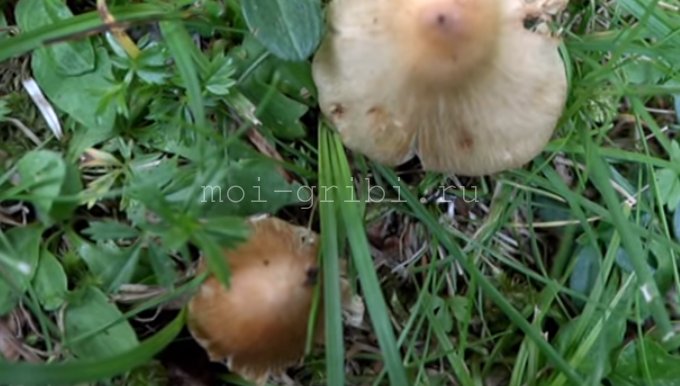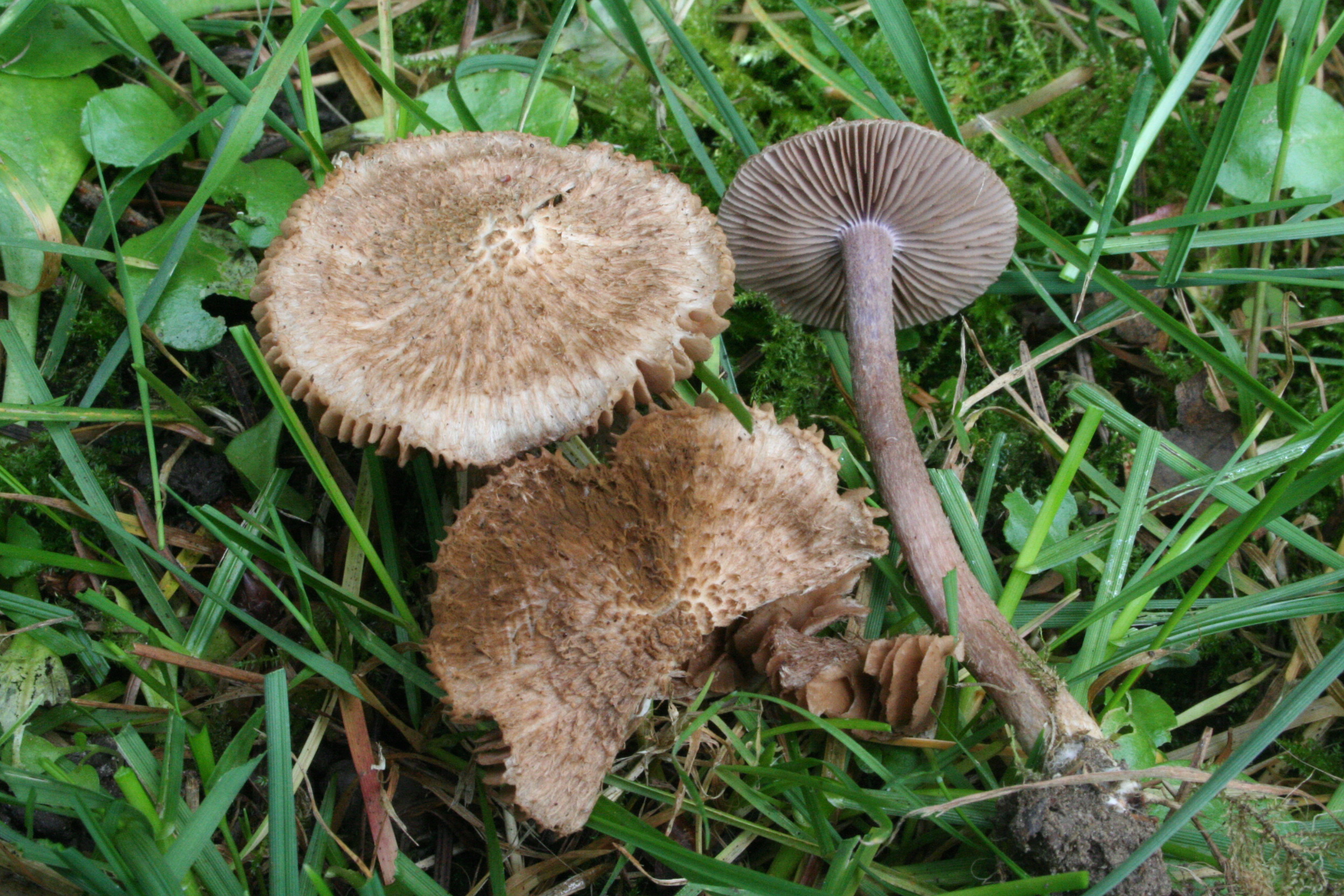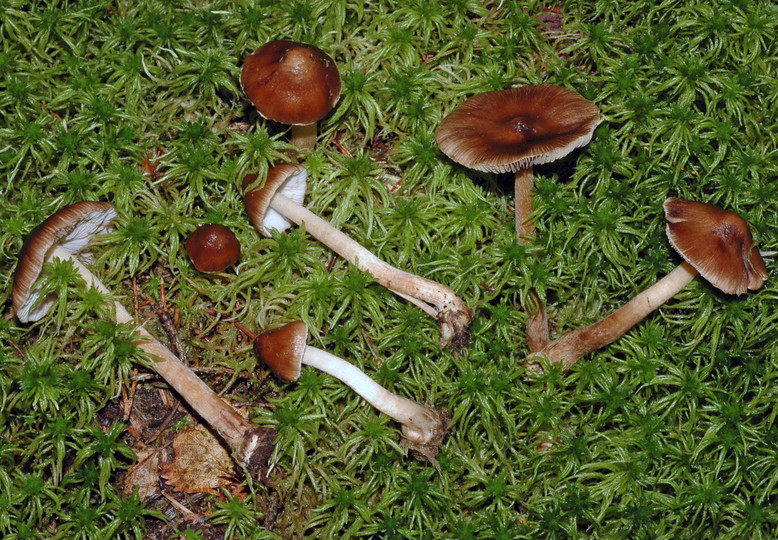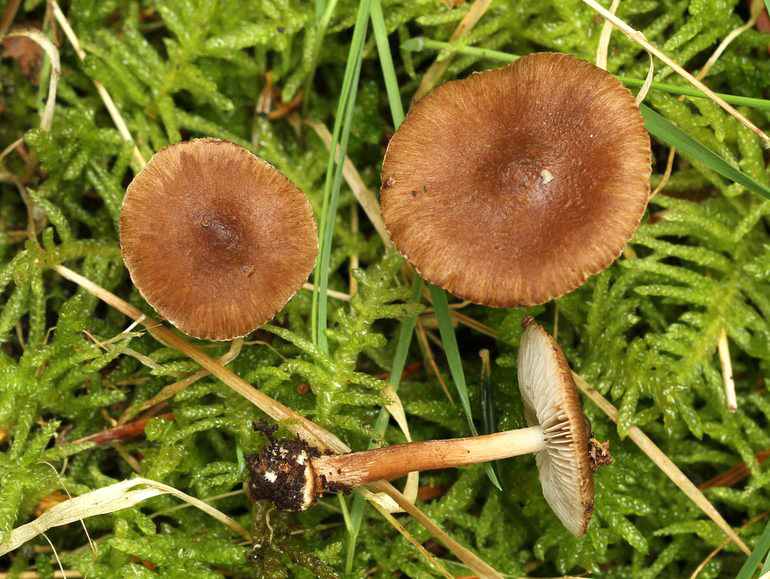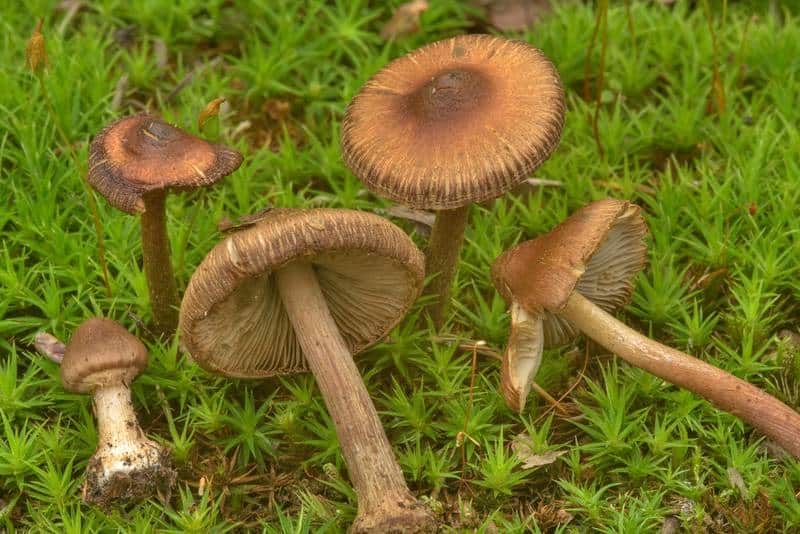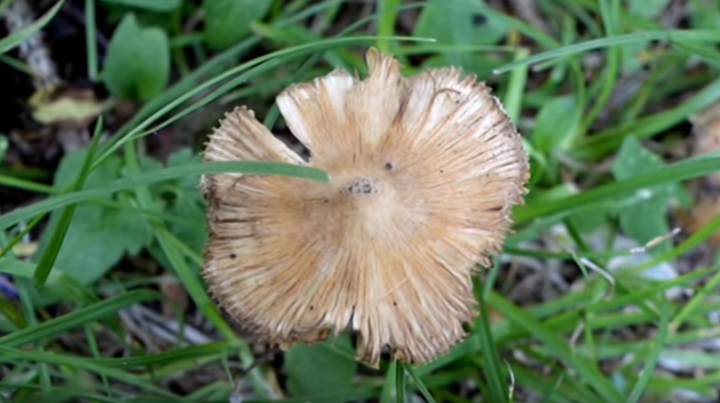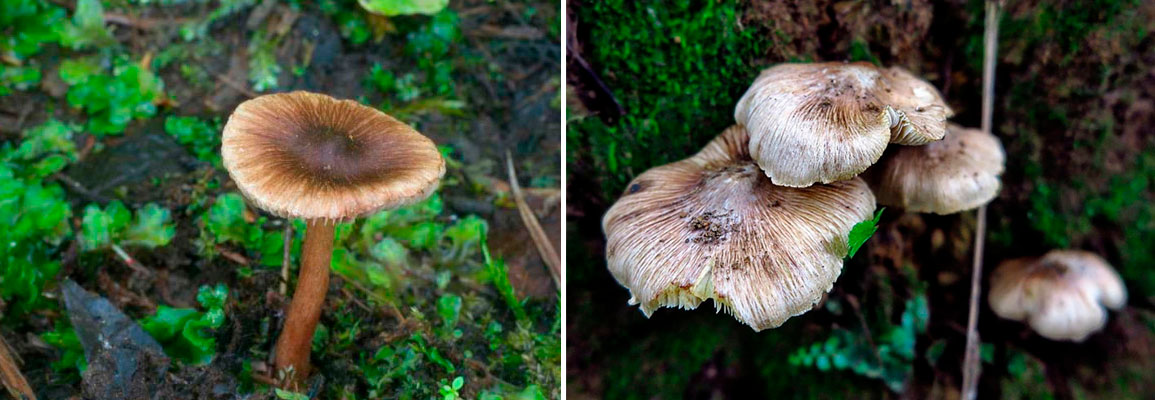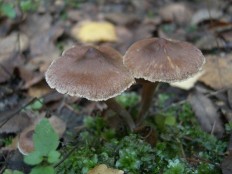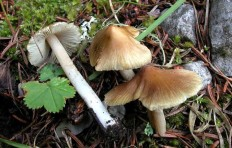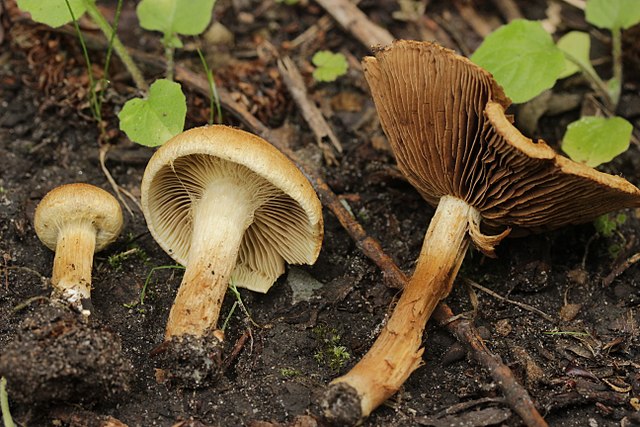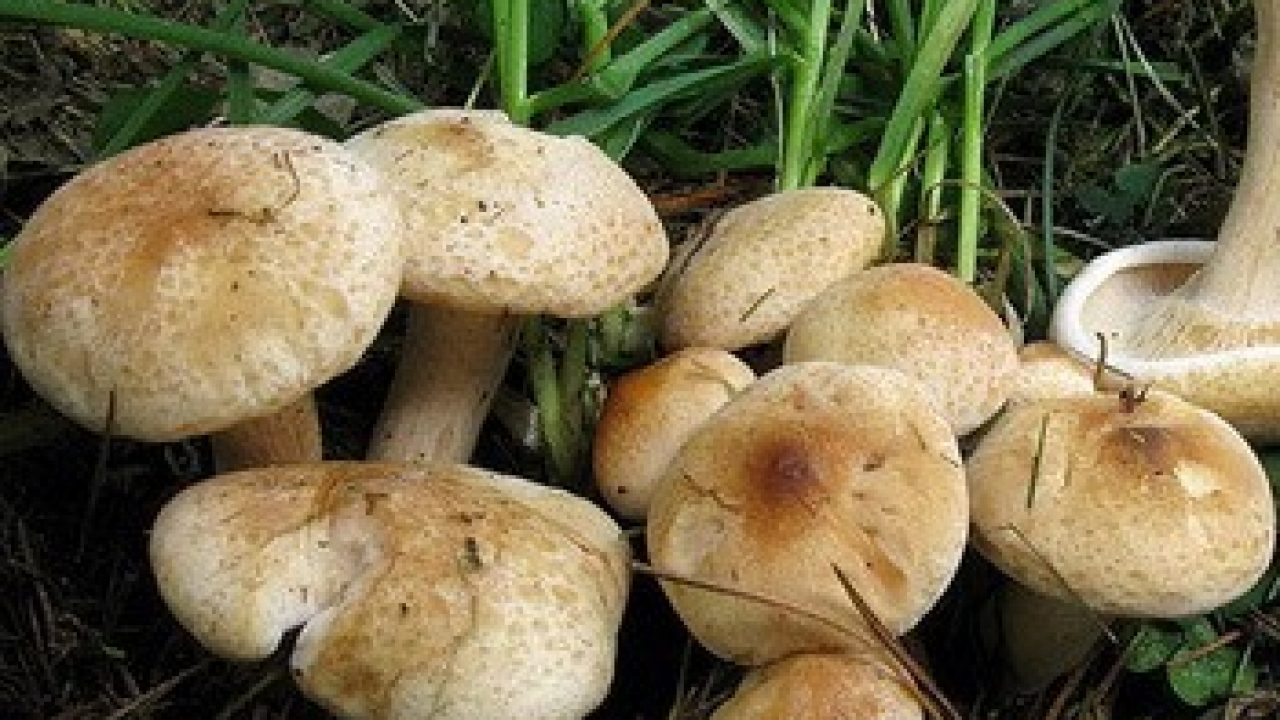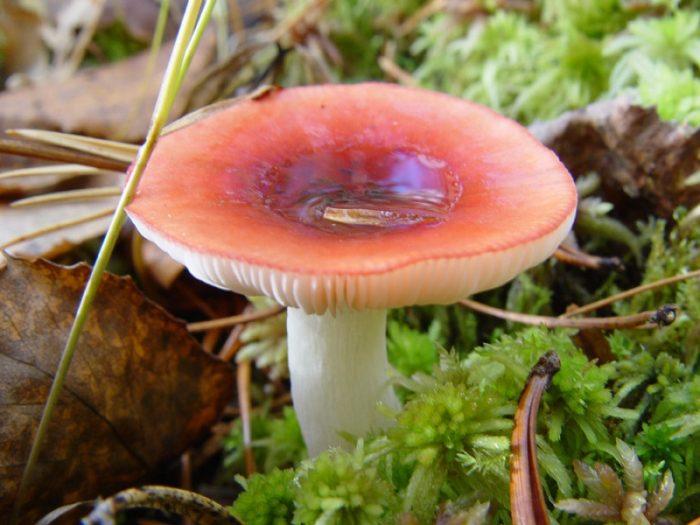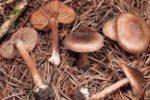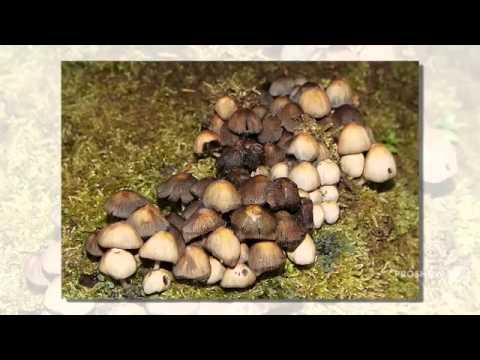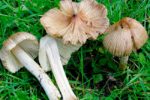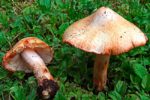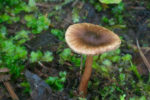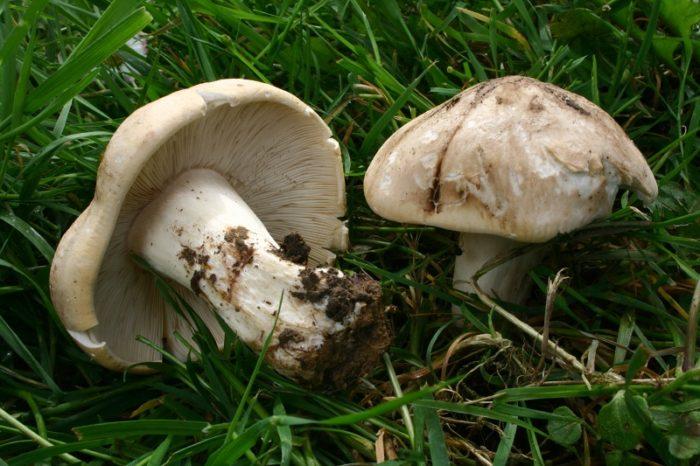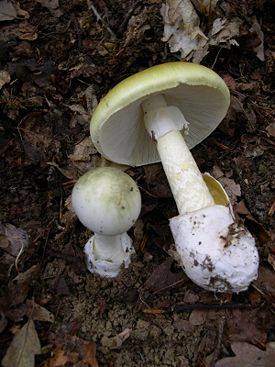Poisoning and first aid
- In the fruiting bodies (mushrooms) there is a high concentration of the substance muscarin, which belongs to toxins. Its content in Fiber patuillard is 25 times higher than in classic red fly agarics.
- The action of the poison affects the functioning of the autonomic nervous system. When ingested in high doses, muscarine causes death due to the arrest of the heart muscle and the cessation of respiratory function. On average, depending on the weight of a person, a lethal dose will be from 10 to 80 g of fresh fiber pulp.
- The first signs of poisoning appear in the period from 30 minutes to 2 hours after the product is consumed. The victim develops lacrimation, there is a sharp drop in pressure and pulse. Further breathing is disturbed, profuse diarrhea and vomiting begin. The patient's condition deteriorates sharply as the symptoms increase. If you suspect poisoning, you need to urgently call an ambulance, and before that, provide first aid.
- Before the arrival of the doctors, if possible, they wash the victim's stomach. He also needs to drink crushed activated carbon, dissolved in water, or another fast-acting sorbent, which, even in small doses, is not absorbed by the body. Inducing vomiting is necessary only if it is known that a poisonous mushroom has been eaten, but the symptoms of poisoning have not yet appeared. Without medical assistance, the risk of death of the victim is very high.
- Poisonous mushrooms are often similar to edible ones. A careful study of its features will allow you to avoid poisoning with the Fiber Catouillard. A novice mushroom picker should not put dubious specimens in the basket, but rather go on a quiet hunt accompanied by a knowledgeable companion.
LAT Inocybe patouillardii Inedible Synonyms: Inocybe erubescens
Specifications:
| Group: | Lamellar |
|---|---|
| Plates: | Pink, brown |
| Colour: | Various tones of reddish shades |
| Info: | The pulp turns red at the break |
Systematics:
| Department: | Basidiomycota (Basidiomycetes) |
|---|---|
| Subdivision: | Agaricomycotina (Agaricomycetes) |
| Class: | Agaricomycetes (Agaricomycetes) |
| Subclass: | Agaricomycetidae |
| Order: | Agaricales (Agaric or Lamellar) |
| Family: | Inocybaceae (Fiber) |
| Genus: | Inocybe (Fiber) |
| View: | Inocybe patouillardii (Patuillard fiber) |
Knowing the main signs by which you can distinguish dangerous poisonous mushrooms is no less important than being able to distinguish edible species. And perhaps this is more important - in the end, it can save the life of you and your loved ones
To what mushrooms, as a fibrous patuyard, this applies doubly. The content of the deadly poison muscarine in it is so high that the concentration of this toxin exceeds the pulp of a red fly agaric by 20 times.
General botanical characteristics
Fibers belonging to the genus Fibers have hat-pectus fruiting bodies. The shape of the mushroom cap is conical or bell-shaped. In the central part, there is often a tubercle in age fungi. The surface structure is fibrous, silky, in some specimens covered with scales, sometimes radially cracked.
The mushroom leg is silky in structure, often covered with scales. The color is pale brown or brown.
The genus Fiber combines about 150 species growing in forests on soil and among grass plantings. There are about 100 species growing in Russia. The most famous:
- v. earthen;
- v. Patuillara;
- v. sharp;
- v. whitening;
- v. blushing;
- v. blue.
Irina Selyutina (Biologist):
Fibers often have a specific unpleasant or fruity aroma. They grow on soil in forests, some of the species are mycorrhiza formers.Among them there are deadly poisonous mushrooms. Signs of poisoning may appear after 1.5-2 hours. In this case, the following symptoms are noted:
- profuse salivation and sweating;
- chills;
- convulsions;
- weakening of vision.
In especially severe cases, due to a drop in cardiac activity, death may occur or a person falls into a prolonged unconsciousness. Respiratory distress is also common. Recovery or death from fiber toxins occurs on the second day.
Fibers can be an example:
- forest litter saprophytes, for example, Inocybe obscura, growing mainly in coniferous forests, etc .;
- humus saprophytes growing on soil: most species of the genus.
Chemical composition
The fiber pulp contains many neurotoxic substances - muscarine and psilocybin. In different types of fiber, the ratio of these two substances is significantly different. So, the maximum amount of muscarine is contained in the Patuillard fiber, and the highest content of psilocybin is noted in a bluish-green form.
Alkaloid muscarine
The poisonous substance - the alkaloid muscarine - in the human body is able to excite a group of cholinergic receptors, which are located in the membranes of postganglionic (postnodal) nerves. These receptors are called M-receptors, that is, muscarinic. Binding to these receptors explains the powerful neurotoxic effect of muscarin, as a result of which a spasm of smooth muscles of the walls of internal organs occurs, the lumens of peripheral vessels expand, the heart rhythm slows down and the secretory functions of the glands increase.
By binding to M-receptors, muscarine stimulates spastic contraction of the smooth muscle layer of the walls of the digestive system. Acceleration of intestinal motility leads to severe abdominal pain and diarrhea. As a result of strong contractions of the stomach walls, vomiting occurs.
In addition to spasm of the smooth muscles of the digestive system, muscarine causes contraction of the smooth muscle layers of the gallbladder, spleen, uterus, bladder, bronchi, salivary and sweat glands, lacrimal sacs.
Hallucinogen psilocybin
Psilocybin is a psychedelic (hallucinogenic) substance. The chemical formula of this compound is similar to the serotonin molecule, which is responsible for the transmission of nerve impulses at synapses. By blocking serotonin receptors, psilocybin induces euphoria, visual and auditory hallucinations. Under its influence, a person loses the sense of time. Due to such psychotropic actions, mushrooms containing this hallucinogen have long been used in ritual practices.
In addition to psychotropic effects, psilocybin exhibits other properties:
- dilates the pupils;
- causes cardiac arrhythmias and blood pressure instability;
- increases the amplitude of the knee reflex;
- provokes a gag reflex;
- disrupts the coordination of movements.
Repeated use of psilocybin increases the body's tolerance to this substance, causing addiction to it. The high content of this substance in mushrooms is indirectly indicated by the bluish color of their pulp, which occurs as a result of the oxidation of phenols.
Torn fiber: edibility, description and photo
| Name: | Broken fiber |
| Latin name: | Inocybe lacera |
| Type of: | Inedible, Poisonous |
| Specifications: | |
| Systematics: |
|
Torn fiber (Inocybe lacera) is a poisonous representative that mushroom pickers should not be put in their basket. It grows in the mushroom season, when there are a lot of honey mushrooms, russula, champignons
It is important to distinguish fiber from other lamellar mushrooms that are conditionally edible, otherwise urgent medical attention will be required
What does a torn fiber box look like?
The torn fiber is small in size. Her hat is like a bell with a tubercle in the middle. It is colored in light brown, sometimes with a yellow tint, has a diameter of 1 to 5 cm. With age, the surface of the mushroom darkens, acquiring a brown color, the cap cracks along the edges. A thin cover in the form of a cobweb sometimes hangs from the fiber.
The stem of the mushroom can be either straight or curved, light brown with reddish scales. Its length does not usually exceed 8 cm, and its thickness is 1 cm. Wide brownish plates are spliced with the stem. Spores are orange-brown. The flesh inside is yellowish-white at the cap and reddish at the stem.
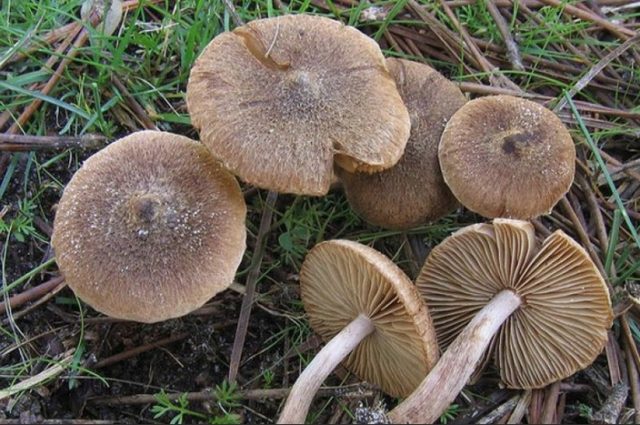
Where the torn fiber grows
Broken fiber grows in damp coniferous and deciduous forests, willow and alder thickets. It can be found on the side of forest paths and ditches. She prefers sandy soils and shady secluded spots where good edible mushrooms grow.
Fibers are found both in numerous groups and singly. The fruiting season lasts from July to September.
Is it possible to eat a torn fiber
The mushroom has a mild odor and bitter taste, which at first feels sweet, but not worth eating. The torn fiber is poisonous, its use leads to death, if you do not provide assistance to the victim in time. The mushroom pulp contains a dangerous poison - muscarine in a concentration that is ten times higher than that of a red fly agaric.
The toxicity of the mushroom is not reduced as a result of heat treatment. Toxins are retained after cooking, drying, freezing. One torn fiber, caught in the mushroom harvest, can ruin all preservation or dishes for the everyday table.
Poisoning symptoms
Inexperienced mushroom pickers can confuse fiberglass with honey agarics; cases of poisoning with these mushrooms have been described. It gets very bad after about 20 minutes. after eating the fiber torn for food. A severe headache begins, the pressure rises, the limbs tremble, the skin turns red.
Muscarine, which is found in mushrooms, causes saliva and sweat, severe cramps in the stomach, intestines and other organs. There is a sharp pain in the abdominal cavity, vomiting and diarrhea. The heart rate slows down, the pupils are greatly narrowed, and visual impairment occurs. With a large amount of poison, cardiac arrest occurs.
First aid for poisoning
At the first symptoms of poisoning, you must call an ambulance. Before the arrival of doctors, they try to provoke vomiting in the victim and give an enema to remove the contents of the stomach and intestines. Fortunately, there is an antidote for muscarine - atropine, but doctors will inject it. Before the ambulance arrives, you can use any sorbent - activated carbon, Filtrum or Smecta.
In the hospital, where the victim will be taken, his stomach will be washed with a tube. If symptoms consistent with muscarine poisoning develop, atropine will be administered subcutaneously as an antidote. They will make a dropper to improve the general condition.
If the dose of toxins is small and first aid for poisoning was provided on time, the prognosis of treatment is favorable. The use of inedible mushrooms by children is especially dangerous. They need a much lower dose of muscarine to stop their heart than adults, and help may not come in time.
Conclusion
Torn fiber is a dangerous representative that should not be confused with honey agarics, champignons and other lamellar mushrooms. It contains the deadly poison muscarine, which causes vomiting and diarrhea, severe stomach pain, and cardiac arrest. The victim needs immediate help, since the poison begins to act within 20-25 minutes after eating the torn fiber.
Definitioner
- Basidia (Basidia)
-
Lat. Basidia.A specialized structure of sexual reproduction in fungi, inherent only in Basidiomycetes. Basidia are terminal (end) elements of hyphae of various shapes and sizes, on which spores develop exogenously (outside).
Basidia are diverse in structure and method of attachment to hyphae.
According to the position relative to the axis of the hypha, to which they are attached, three types of basidia are distinguished:
Apical basidia are formed from the terminal cell of the hypha and are located parallel to its axis.
Pleurobasidia are formed from lateral processes and are located perpendicular to the axis of the hypha, which continues to grow and can form new processes with basidia.
Subasidia are formed from a lateral process, turned perpendicular to the axis of the hypha, which, after the formation of one basidium, stops its growth.
Based on morphology:
Holobasidia - unicellular basidia, not divided by septa (see Fig. A, D.).
Phragmobasidia are divided by transverse or vertical septa, usually into four cells (see Fig. B, C).
By type of development:
Heterobasidia consists of two parts - hypobasidia and epibasidia developing from it, with or without partitions (see Fig. C, B) (see Fig. D).
Homobasidia is not divided into hypo- and epibasidia and in all cases is considered holobasidia (Fig. A).
Basidia is the place of karyogamy, meiosis and the formation of basidiospores. Homobasidia, as a rule, is not functionally divided, and meiosis follows karyogamy in it. However, basidia can be divided into probasidia - the site of karyogamy and metabasidia - the site of meiosis. Probasidium is often a dormant spore, for example in rust fungi. In such cases, probazidia grows with metabasidia, in which meiosis occurs and on which basidiospores are formed (see Fig. E).

See Karyogamy, Meiosis, Gifa.
- Pileipellis
-
Lat. Pileipellis, skin - differentiated surface layer of the cap of agaricoid basidiomycetes. The structure of the skin in most cases differs from the inner flesh of the cap and may have a different structure. The structural features of pileipellis are often used as diagnostic features in descriptions of fungi species.
According to their structure, they are divided into four main types: cutis, trichoderma, hymeniderma and epithelium.
See Agaricoid fungi, Basidiomycete, Cutis, Trichoderma, Gimeniderm, Epithelium.
- Cutis
-
The type of cap skin, consists of creeping non-gelatinized hyphae located parallel to the surface. The surface of the cap looks smooth.
Lat. Cutis.
See Gifa.
Description of the green fiber
The diameter of the green fiber cap is 2.5-9 centimeters. At first, the shape of the cap is rounded-bell-shaped, while its edges are wrapped inward, after which it becomes convex-outstretched with a central tubercle of an acute or obtuse shape.
The surface of the cap is felt-fibrous, scaly, cracking. The color of the cap is gray-green, olive green or dark brown, and the edges are nutty brown, usually with darker scales.
The color of the plates is at first gray-cream or whitish, but over time they become reddish-brown, sometimes their edges are white. When damaged, the plates turn slightly red. In the tubercle of the cap, the flesh is whitish, and at the base it is bluish-green. When cut, the flesh may turn pink. The pulp has a pleasant fruity aroma.

The leg is 2.5-10 centimeters long and 0.5-1 centimeters wide. The leg is cylindrical or thickened towards the base. The leg is fibrous, at first it is whitish, then in the lower part it becomes grayish-buffy with greenish spots, and in the upper part of the leg there is a flocculent hairy bloom.
Spores are ellipsoidal, unequal, light brown in color. Spore powder of brown or yellowish-brown color.
Places of growth of green fiber
These mushrooms form mycorrhiza with beech, oak and spruce. They grow in deciduous, mixed and coniferous forests. In our country, they are distributed throughout the temperate forest zone, giving preference to the south.They are often found along the edges of the roads.
Fruiting occurs in July-October. They grow on the ground singly or in groups.

False doubles
The danger of inocyba lies in its similarity with other species that do not contain toxins. It is useful for the mushroom picker to study the photo of the Patouillard fiber and similar specimens in order to better understand what the differences are.
Edible mushrooms with which this species can be confused:
- Ryadovka May or May mushroom - the main differences are the absence of red in the color of the cap and a pronounced flour smell;
- russula - not very similar to a poisonous species, but novice mushroom pickers can still make a mistake. The russula, unlike the fiber, has the usual mushroom smell, the flesh does not turn red in the places of pressure and there is no tubercle in the center of the cap;
- Royal champignon is a delicious edible mushroom that is somewhat similar to the poisonous inocyba. However, its color does not have a red tint, the fruit does not turn red when pressed, and the plates on the inside of the cap are beige.
The toxic counterpart is the less poisonous mushroom Fibers Gode, which differs only in its smaller size and a leg that is swollen at the bottom. Red tints are also present in the coloration.
The photographs show exactly how the Patuillard fiber differs with similar appearance. Even a beginner will be able to determine the characteristics of mushrooms.
Fractured fiber
Fractured fiber - Latin Inocybe rimosa
Otherwise, this poisonous creature is called a conical fiber or a conical fiber.
Description
Mushroom cap
The cone-shaped fiber has a medium-sized cap, reaching 20-70 mm in diameter. When it is born, it has the shape of a pointed cone with tucked edges, then it opens almost to the end, while maintaining a pronounced top. Over time, the edges are severely split and discolored.
The hats are covered with highly cracked (especially at the edges) fibrous skin of a golden yellow, dark brown or ocher hue. The central part is usually darker. On fine days, the skin remains dry and silky, in rainy weather it is moisturized, becoming slippery.
The hat is filled with a fragile, disgusting smelling pulp of a whitish tone.
The hat bottoms are trimmed with frequent accreting plates of a pale yellow, later - olive-yellow and brownish shades.
Conical fiber reproduces by elliptical smooth dirty yellow or brownish spores.
Stipe
Fractured fiber has a straight cylindrical leg thickening from top to bottom with a thickness of about 0.4-1 cm and a height of 40-110 mm. It is covered with a smooth surface of white or white - ocher tone.
Fractured fiber - Latin Inocybe rimosa
Growing places
These mushrooms prefer well-fertilized soil, and settle in forests of any type that grow in North African, European, Asian, Russian, North American and South American soil. They are found on the sides of forest paths and roads, in meadows and in park areas. The main thing is that hardwood trees grow nearby.
Fruiting of fibula occurs in numerous colonies in July - September.
Edibility
This fiber contains a lot of muscarine - a natural alkaloid that affects the autonomic nervous system and various organs, and therefore the mushroom is not edible.
A couple of hours after eating such mushrooms, a person begins to see poorly, "choke" with saliva, sweat heavily, he is nauseous and vomits, he suffers from diarrhea and interruptions in the heartbeat, and blood pressure rises. If medical attention is not provided in a timely manner, suffocation or cardiac arrest may occur.
This mushroom can only be used for medical purposes: on its basis, medicines are made for the treatment of eczema.



